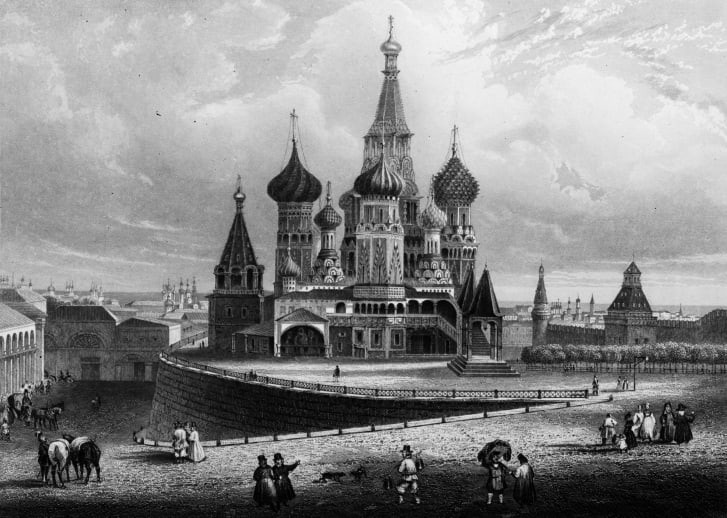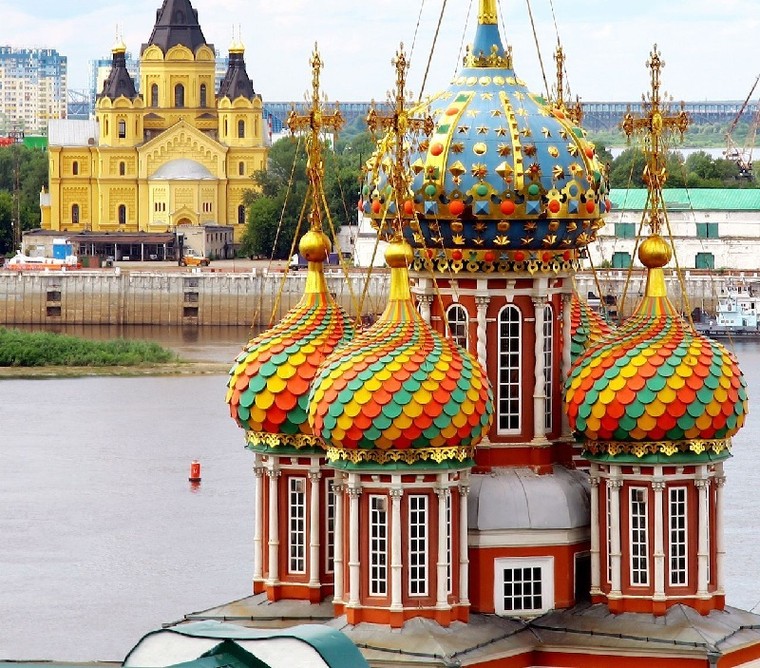St. Basil's Cathedral - a great building with a mysterious history
St. Basil's Cathedral in Red Square, Moscow, Russia is one of the most famous religious structures in the world. Experiencing many historical ups and downs, this work can be considered a witness to a historical period of many changes and conflicts, and a symbol of Russian culture.
St. Basil's Cathedral, a famous Orthodox church in the center of Moscow (Russia), is an architectural marvel of the land of birch. Located in Red Square, this is also the tallest building in Moscow.
After its completion in the mid-16th century, a legend about St. Basil's Cathedral was born. Legend has it that Tsar Ivan IV, also known as "Ivan the Tyrant", ordered the architect Postnik Yakovlev to be blinded so that he could not design any more projects. so great again. In fact, the architectural origin of St. Basil's Cathedral is still shrouded in mystery. Five centuries have passed, but people still cannot determine the identity of the architects who designed St. Basil's Cathedral. The most popular opinions are that two architects, Barma and Postnik Yakovlev, are the ones who created this project. Some historians assert that Postnik Yakovlev is the only author, because "Barma" is actually his nickname.
Five centuries have passed, but people still cannot determine the identity of the architects who designed St. Basil's Cathedral. The most popular opinions are that two architects, Barma and Postnik Yakovlev, are the ones who created this project. Some historians assert that Postnik Yakovlev is the only author, because "Barma" is actually his nickname.
William Brumfeld, a Russian historian and author of “Journey Through the Russian Empire,” commented: “I feel very surprised, when the basic facts about St. Basil's Cathedral come to this day. is still undiscovered. Documentation about the construction process of St. Basil's Cathedral is very scarce, forcing historians like Brumfield to actively hunt for "clues", no matter how small. “We have encountered this problem many times, including with buildings built in the late 18th century - much closer to the present than St. Basil's Cathedral. There have been many fires, floods and wars, causing documents to often be lost.
Documentation about the construction process of St. Basil's Cathedral is very scarce, forcing historians like Brumfield to actively hunt for "clues", no matter how small. “We have encountered this problem many times, including with buildings built in the late 18th century - much closer to the present than St. Basil's Cathedral. There have been many fires, floods and wars, causing documents to often be lost.
Today, St. Basil's Cathedral is an architecture consisting of a series of chapels surrounding the main church, all built of red brick. Above each chapel is a dome decorated with colorful colors such as blue, green, red and yellow. The church is famous all over the world because its exterior resembles castles in fairy tales. Attracting about 400,000 tourists each year, this place has become an important symbol of Russian culture.
Over the centuries, St. Basil's Cathedral has gone through many ups and downs, including two times it was almost completely destroyed. The year 1812 marked the first time, when Emperor Napoleon invaded Moscow. He ordered explosives to be planted to destroy the entire church. Fortunately, a heavy rain fell on Moscow, extinguishing all detonations and saving the church from disaster. The second time was in 1930, when the Supreme Leader of the Soviet Union, Stalin, almost agreed to destroy the church, due to obstructing the path of the parade. St. Basil's Cathedral can be considered a witness of political upheavals in Russia from the 16th to the 20th century.
Symbol of power
Construction of St. Basil's Cathedral began in 1555 under the direction of Tsar Ivan IV, aiming to honor Russia's victory over the Kazan Khanate. Initially, the building was named "Holy Trinity Church".  “The church has a very clear political meaning. It is a symbol of the power of Tsar Ivan IV, who is considered the first Tsar of Russia,” said historian Brumfeld.
“The church has a very clear political meaning. It is a symbol of the power of Tsar Ivan IV, who is considered the first Tsar of Russia,” said historian Brumfeld.
The name “St. Basil's Cathedral” appeared after Fyodor, son of Ivan the tyrant, took power in his father's place. He built an additional chapel dedicated to Saint Vasily, or Saint Basil - considered the reincarnation of Tsar Ivan IV. Therefore, the chapel dedicated to St. Basil was placed on top of the vault containing the remains of the first Tsar. This is the chapel that attracts the most visitors and prayers.
According to Brumfeld, Russian architects of that time were certainly inspired by Italian architectural styles. It's a style that has created towering structures, solidly built with red bricks - like the dome of Florence Cathedral. Another famous building, the Kremlin, was also influenced by this architectural style, when it was rebuilt by Italian architects from 1475 to 1510. The chapels at St. Basil's Cathedral are arranged in an almost symmetrical layout. In each chapel is an altar dedicated to a saint associated with the power of Tsar Ivan IV.
Colorful onion domes According to Brumfeld, St. Basil's Cathedral may have been one of the first buildings to have an onion-shaped dome architecture. “No one is sure when onion dome architecture was born in Russia. As soon as it appeared, priests adopted this architecture and replaced domes across Russia with onion domes. Over the centuries, this architecture has remained very popular,” said historian Brumfeld. Based on hypotheses, Brumfeld predicts that St. Basil's Cathedral adopted the onion dome architecture of the Ottoman Empire, or referenced the architecture of the Church of the Holy Sepulcher in Jerusalem.
“No one is sure when onion dome architecture was born in Russia. As soon as it appeared, priests adopted this architecture and replaced domes across Russia with onion domes. Over the centuries, this architecture has remained very popular,” said historian Brumfeld. Based on hypotheses, Brumfeld predicts that St. Basil's Cathedral adopted the onion dome architecture of the Ottoman Empire, or referenced the architecture of the Church of the Holy Sepulcher in Jerusalem.
At that time, Russians began to consider their territory as sacred land,” Brumfeld explains. At that time, Jerusalem and the former capital of the Roman Empire, Constantinople, were ruled by the Ottomans. Not only that, the power of the Pope is also not recognized. Russians believe that opened the door for the city to become a sacred capital.
The colors of the onion domes of St. Basil's Cathedral were added gradually over time, as new architectural trends favored vivid colors. “Russians love colorful buildings,” Brumfeld said. According to him, Russia often experiences winters with gloomy, dark skies. Therefore, colorful architecture will make the surrounding landscape more lively
St. Basil's Cathedral is not the only brightly colored building in Russia. Those works are scattered across this country's territory. One of them is the Stroganov church in Nizhny Novgorod, a church that stands out with its yellow, festive feel, or the bright red, blue-roofed Church of Our Lady of Kazan in Irkutsk.










































































